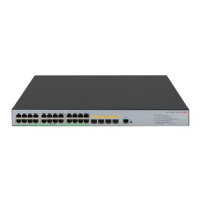394
To configure an IPv6 PIM border domain:
Ste
Command Remarks
1. Enter system view.
system-view N/A
2. Enter interface view.
interface interface-type
interface-number
N/A
3. Configure an IPv6 PIM
domain border.
pim ipv6 bsr-boundary
No IPv6 PIM domain border is
configured by default.
Configuring C-BSR parameters globally
In each IPv6 PIM-SM domain, a unique BSR is elected from C-BSRs. The C-RPs in the IPv6 PIM-SM domain
send advertisement messages to the BSR. The BSR summarizes the advertisement messages to form an
RP-set and advertises it to all routers in the IPv6 PIM-SM domain. All the routers use the same hash
algorithm to get the RP address that corresponds to specific IPv6 multicast groups.
Perform the following configuration on C-BSR routers.
To configure C-BSR parameters globally:
Ste
Command Remarks
1. Enter system view.
system-view N/A
2. Enter IPv6 PIM view.
pim ipv6 N/A
3. Configure the hash mask
length.
c-bsr hash-length hash-length
Optional.
126 by default.
4. Configure the C-BSR priority.
c-bsr priority priority
Optional.
64 by default.
Configuring C-BSR timers
The BSR election winner multicasts its own IPv6 address and RP-Set information throughout the region to
which it is designated through bootstrap messages. The BSR floods bootstrap messages throughout the
network at the interval of the BS (BSR state) period. Any C-BSR that receives a bootstrap message retains
the RP-set for the length of BS timeout, during which no BSR election occurs. If no bootstrap message is
received from the BSR before the BS timeout timer expires, a new BSR election process begins among the
C-BSRs.
Perform the following configuration on C-BSR routers.
To configure C-BSR timers:
Ste
Command
Remarks
1. Enter system view.
system-view N/A
2. Enter IPv6 PIM view.
pim ipv6 N/A

